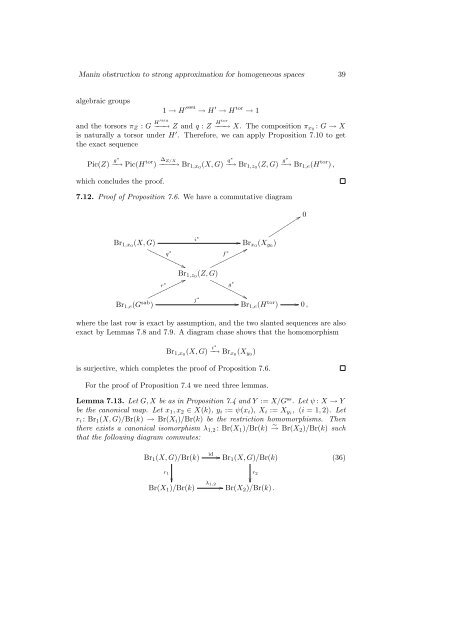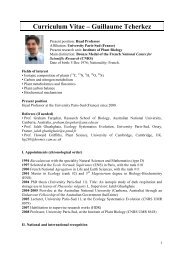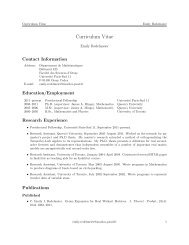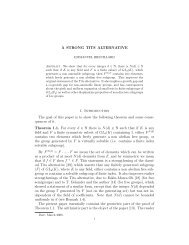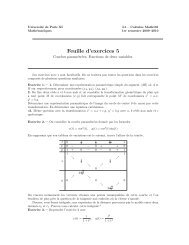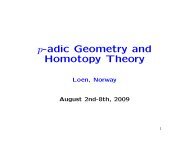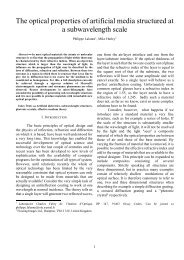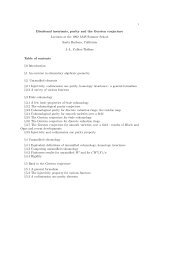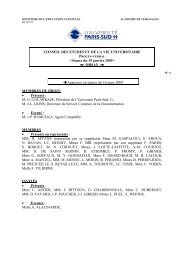Manin obstruction to strong approximation for homogeneous spaces
Manin obstruction to strong approximation for homogeneous spaces
Manin obstruction to strong approximation for homogeneous spaces
You also want an ePaper? Increase the reach of your titles
YUMPU automatically turns print PDFs into web optimized ePapers that Google loves.
<<strong>strong</strong>>Manin</<strong>strong</strong>> <<strong>strong</strong>>obstruction</<strong>strong</strong>> <<strong>strong</strong>>to</<strong>strong</strong>> <strong>strong</strong> <strong>approximation</strong> <strong>for</strong> <strong>homogeneous</strong> <strong>spaces</strong> 39algebraic groups1 → H ′ ssu → H ′ → H <<strong>strong</strong>>to</<strong>strong</strong>>r → 1and the <<strong>strong</strong>>to</<strong>strong</strong>>rsors π Z : G H′ssu−−→ Z and q : Z H<<strong>strong</strong>>to</<strong>strong</strong>>r−−→ X. The composition π x0 : G → Xis naturally a <<strong>strong</strong>>to</<strong>strong</strong>>rsor under H ′ . There<strong>for</strong>e, we can apply Proposition 7.10 <<strong>strong</strong>>to</<strong>strong</strong>> getthe exact sequencePic(Z) −→ g∗Pic(H <<strong>strong</strong>>to</<strong>strong</strong>>r ) ∆ Z/X−−−−→ Br 1,x0 (X, G) −→ q∗Br 1,z0 (Z, G) −→ g∗Br 1,e (H <<strong>strong</strong>>to</<strong>strong</strong>>r ) ,which concludes the proof.7.12. Proof of Proposition 7.6. We have a commutative diagram iBr 1,x0 (X, G)∗ Br x0 (X y0 )q∗f∗Br 1,z0 (Z, G)r g ∗∗Br 1,e (G sab j ∗) Br 1,e (H <<strong>strong</strong>>to</<strong>strong</strong>>r ) 0 ,where the last row is exact by assumption, and the two slanted sequences are alsoexact by Lemmas 7.8 and 7.9. A diagram chase shows that the homomorphismBr 1,x0 (X, G) −→ i∗Br x0 (X y0 )is surjective, which completes the proof of Proposition 7.6.For the proof of Proposition 7.4 we need three lemmas.Lemma 7.13. Let G, X be as in Proposition 7.4 and Y := X/G ss . Let ψ : X → Ybe the canonical map. Let x 1 , x 2 ∈ X(k), y i := ψ(x i ), X i := X yi , (i = 1, 2). Letr i : Br 1 (X, G)/Br(k) → Br(X i )/Br(k) be the restriction homomorphisms. Thenthere exists a canonical isomorphism λ 1,2 : Br(X 1 )/Br(k) ∼ → Br(X 2 )/Br(k) suchthat the following diagram commutes:0Br 1 (X, G)/Br(k)idBr 1 (X, G)/Br(k)(36)r 1Br(X 1 )/Br(k)r 2λ 1,2 Br(X 2 )/Br(k) .


